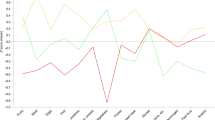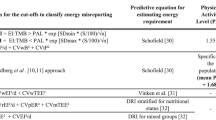Abstract
Objective:
To investigate the reproducibility of food consumption frequencies derived from the food frequency section of the Children's Eating Habits Questionnaire (CEHQ-FFQ) that was developed and used in the IDEFICS (Identification and prevention of dietary- and lifestyle-induced health effects in children and infants) project to assess food habits in 2- to 9-year-old European children.
Design and methods:
From a subsample of 258 children who participated in the IDEFICS baseline examination, parental questionnaires of the CEHQ were collected twice to assess reproducibility of questionnaire results from 0 to 354 days after the first examination. Weighted Cohen's kappa coefficients (κ) and Spearman's correlation coefficients (r) were calculated to assess agreement between the first and second questionnaires for each food item of the CEHQ-FFQ. Stratification was performed for sex, age group, geographical region and length of period between the first and second administrations. Fisher's Z transformation was applied to test correlation coefficients for significant differences between strata.
Results:
For all food items analysed, weighted Cohen's kappa coefficients (κ) and Spearman's correlation coefficients (r) were significant and positive (P<0.001). Reproducibility was lowest for diet soft drinks (κ=0.23, r=0.32) and highest for sweetened milk (κ=0.68, r=0.76). Correlation coefficients were comparable to those of previous studies on FFQ reproducibility in children and adults. Stratification did not reveal systematic differences in reproducibility by sex and age group. Spearman's correlation coefficients differed significantly between northern and southern European countries for 10 food items. In nine of them, the lower respective coefficient was still high enough to conclude acceptable reproducibility. As expected, longer time (>128 days) between the first and second administrations resulted in a generally lower, yet still acceptable, reproducibility.
Conclusion:
Results indicate that the CEHQ-FFQ gives reproducible estimates of the consumption frequency of 43 food items from 14 food groups in European children.
This is a preview of subscription content, access via your institution
Access options
Subscribe to this journal
Receive 12 print issues and online access
$259.00 per year
only $21.58 per issue
Buy this article
- Purchase on Springer Link
- Instant access to full article PDF
Prices may be subject to local taxes which are calculated during checkout
Similar content being viewed by others
References
Willett WC . Nutritional Epidemiology, Monographs in Epidemiology and Biostatistics. 2nd edn. Oxford University Press: New York, 1998.
Lambert J, Agostoni C, Elmadfa I, Hulshof K, Krause E, Livingstone B et al. Dietary intake and nutritional status of children and adolescents in Europe. Br J Nutr 2004; 92/2: S147–S211.
Bammann K, Peplies J, Sjöström M, Lissner L, Henauw S, Iacoviello L et al. Assessment of diet, physical activity and biological, social and environmental factors in a multi-centre European project on diet- and lifestyle-related disorders in children (IDEFICS). J Public Health 2006; 14/5: 279–289.
Ahrens W, Bammann K, de Henauw S, Halford J, Palou A, Pigeot I et al. Understanding and preventing childhood oesity and related disorders—IDEFICS: European multilevel epidemiological approach. Nutr Metab Cardiovas 2006; 16/4: 302–308.
Treiber FA, Leonard SB, Frank G, Musante L, Davis H, Strong WB et al. Dietary assessment instruments for preschool children: reliability of parental responses to the 24-h recall and a food frequency questionnaire. J Am Diet Assoc 1990; 90/6: 814–820.
Northstone K, Emmet PM . Are dietary patterns stable throughout early mid-childhood? A birth cohort study. Br J Nutr 2008; 100/5: 1069–1076.
McPherson R, Hoelscher DM, Alexander M, Scanlon KS, Serdula MK . Dietary assessment methods among school-aged children: validity and reliability. Prev Med 2000; 31: 11–33.
Stevens J, Metcalf PA, Dennis BA, Shimakawa T, Tell GS, Folsom AR . Reliability of a food frequency questionnaire by ethnicity, gender, age and education. Nutr Res 1996; 16/5: 735–745.
USDA/ORC Macro. Developing Effective Wording and Format Options for a Children's Nutrition Behavior Questionnaire for Mothers of Children in Kindergarten. Report no 10. USDA: Washington, 2005.
Suling M, Hebestreit A, Peplies J, Bammann K, Nappo A, Eiben G et al. Design and results of the pretest of the IDEFICS study. Int J Obes 2011; 35 (Suppl 1): S30–S44.
Huybrechts I, Börnhorst C, Pala V, Moreno LA, Barba G, Lissner L et al. Evaluation of the Children's Eating Habits Questionnaire used in the IDEFICS study by relating urinary calcium and potassium to milk consumption frequencies among European children. Int J Obes 2011; 35 (Suppl 1): S69–S78.
Cicchetti DV, Allison T . A new procedure for assessing reliability of scoring EEG sleep recordings. Am J EEG Technol 1971; 11: 101–109.
SAS Knowledge Base. Compare correlations using Fisher's Z transformation. http://support.sas.com/kb/24/995html 2010.
Ahrens W, Bammann K, Siani A, Buchecker K, De Henauw S, Iacoviello L et al. The IDEFICS cohort: design, characteristics and participation in the baseline survey. Int J Obes 2011; 35 (Suppl 1): S3–S15.
Landis JR, Koch GG . The measurement of observer agreement for categorical data. Biometrics 1977; 33/1: 159–174.
Cade JE, Burley VJ, Warm DL, Thompson RL, Margetts BM . Food-frequency questionnaires: a review of their design, validation and utilisation. Nutr Res Rev 2004; 17/1: 5–22.
Rockett HR, Wolf AM, Colditz GA . Development and reproducibility of a food frequency questionnaire to assess diets of older children and adolescents. J Am Diet Assoc 1995; 95/3: 336–340.
Metcalf PA, Scragg RK, Sharpe S, Fitzgerald ED, Schaaf D, Watts C . Short-term repeatability of a food frequency questionnaire in New Zealand children aged 1–14 y. Eur J Clin Nutr 2003; 57/11: 1498–1503.
Huybrechts I, De Baker G, De Bacquer D, Maes L, De Henauw S . Relative validity and reproducibility of a food-frequency questionnaire for estimating food intakes among Flemish preschoolers. Int J Environ Res Public Health 2009; 6/1: 382–399.
Buzzard IM, Stanton CA, Figueiredo M, Fries EA, Nicholson R, Hogan CJ et al. Development and reproducibility of a brief food frequency questionnaire for assessing the fat, fiber, and fruit and vegetable intakes of rural adolescents. J Am Diet Assoc 2001; 101/12: 1438–1446.
Cade J, Thompson R, Burley V, Warm D . Development, validation and utilisation of food-frequency questionnaires—a review. Public Health Nutr 2002; 5/4: 567–587.
Fleiss JL . Statistical Methods for Rates and Proportions. John Wiley & Sons: Chichester, 1981.
Ibiebele TI, Parekh S, Mallitt KA, Hughes MC, O’Rourke PK, Webb PM . Reproducibility of food and nutrient intake estimates using a semi-quantitative FFQ in Australian adults. Public Health Nutr 2009; 12/12: 2359–2365.
Acknowledgements
This study was conducted as part of the IDEFICS study (http://www.idefics.eu). We gratefully acknowledge the financial support of the European Community within the Sixth RTD Framework Programme Contract No. 016181 (FOOD) and the grant support from the EU for the IDEFICS study.
The information in this document reflects the author's view and is provided as it is.
Author information
Authors and Affiliations
Consortia
Corresponding author
Ethics declarations
Competing interests
The authors declare no conflict of interest.
Additional information
Statement of ethics
We certify that all applicable institutional and governmental regulations regarding the ethical use of human volunteers were followed during this research. Approval by the appropriate ethics committees was obtained by each of the eight centres engaged in the fieldwork. Participants were not subjected to any study procedure before both the children and their parents gave consent for examinations, collection of samples, subsequent analysis and storage of personal data and collected samples. The participating children and their parents could consent to single components of the study while refraining from others.
Rights and permissions
About this article
Cite this article
Lanfer, A., Hebestreit, A., Ahrens, W. et al. Reproducibility of food consumption frequencies derived from the Children's Eating Habits Questionnaire used in the IDEFICS study. Int J Obes 35 (Suppl 1), S61–S68 (2011). https://doi.org/10.1038/ijo.2011.36
Published:
Issue Date:
DOI: https://doi.org/10.1038/ijo.2011.36
Keywords
This article is cited by
-
The role of psychosocial well-being and emotion-driven impulsiveness in food choices of European adolescents
International Journal of Behavioral Nutrition and Physical Activity (2024)
-
Is cardiorespiratory fitness a moderator of the relationship between sugar-sweetened beverage consumption and insulin resistance in schoolchildren?
European Journal of Nutrition (2023)
-
Influence of screen time on diet quality and academic achievement: a mediation analysis
Journal of Public Health (2023)
-
Clustering of lifestyle behaviors and adiposity in early adolescents in Spain: findings from the SI! Program for Secondary Schools
BMC Public Health (2023)
-
Reproducibility and relative validity of a semi-quantitative food and beverage frequency questionnaire for Spanish children aged 3 to 11 years: the COME-Kids F&B-FQ
European Journal of Pediatrics (2023)



